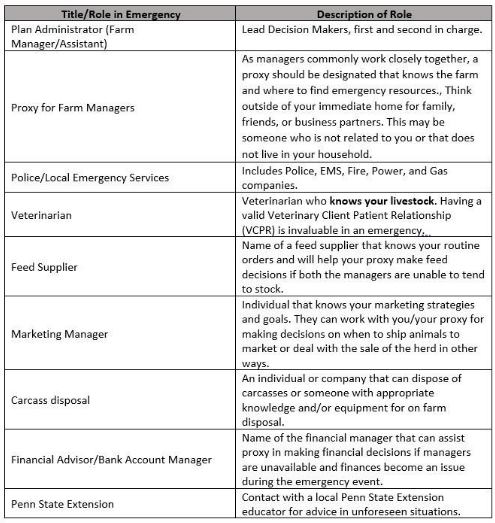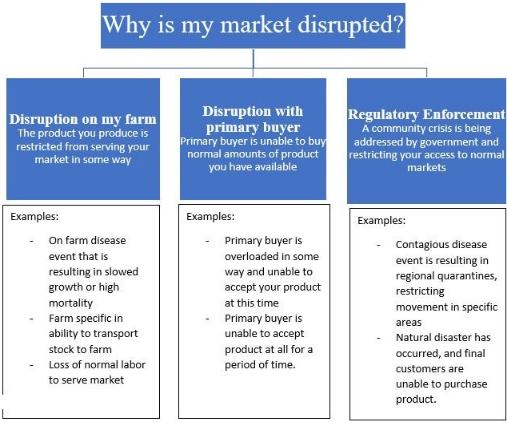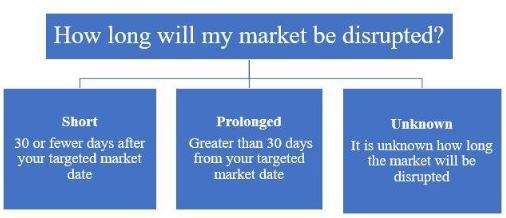BY Elizabeht Hines and Tara L. Felix et.al
Whether you raise pigs, sheep, goats, or cattle, having an emergency plan for their care is critical for animal welfare and business continuity.
Emergency preparedness is critical for all businesses. While it might only be on your mind during an emergency, taking the time to plan-ahead can help you make better decisions during a crisis.
This article will serve as a starting guide to help you collect important information, organize communication, and consider what you will need to prepare your farm for an emergency, particularly an emergency where the primary farm caretaker is unable to be consulted. To prepare your emergency plan, focus on gathering information for these 5 management areas for your farm.
- Emergency Contacts: who to call first when something goes wrong
- Daily Animal Care: how to/who will care for stock if the primary caretaker is unreachable
- Labor Management: how much help do you need in an emergency
- Obtaining Resources: getting what you need to keep the farm going for a short while
- Market Operations: how will you stay in business if your market suddenly disappears
These areas will be used to help you focus on preparing your operation and deciding how to address those preparation areas. Remember it is better to have this contingency plan in place BEFORE something happens, so you can prepare your emergency contacts with training and information before a crisis hits.
There are a variety or resources available for building an emergency response plan. This article will feature some important considerations when building emergency plan.
Emergency Contacts
In any emergency, having ready a list of people to contact is critical. This list serves several purposes, but predominantly, this list helps by functioning as: 1.) a reference to make quick decisions, and 2.) for reference for others in the instance that the farm decision maker is unavailable. Both reasons mean you should seriously consider the capacity of the individuals on your list to make responsible decisions in your absence, particularly for those caring for livestock during an emergency. Use the table below to build your emergency contact list. This is just a start, and you may have more individuals to add to this list.

Daily Animal Care
In any emergency, communication will be key. Having a list of the daily chores that need to be done, down to the amount and timing of when your animals need fed and watered, can be critical if the primary caretakers are unavailable. In an emergency, records very easily go to the wayside and the focus is on immediate animal care. Try your best to write out your "basic" chore/to do list each day. Keep the mindset: “If I’m not here, what are the tasks that HAVE to be done each day?”. Ask yourself these questions to start building your emergency animal care list.
- How much feed do I need, per day, for each group of animals? Where do I keep information on their rations?
- How often do I take feed & water to my animals? Is this different for each season of the year? While the answer is typically daily, it is important if your answer is NOT daily. This applies to livestock that can utilize pasture for their sole feed source daily (does not apply to pigs) OR are on a free choice feed system that does not require daily addition of feed to an in-pen feeder.
- How do I manage ventilation? Automated ventilation systems need checked to verify function, whereas manual ventilation is usually changed by feel or knowledge of the caretaker. Ventilation is easy to over-look, yet mismanagement can be deadly to stock. Be sure to highlight how ventilation needs managed.
- How often do you remove manure or change bedding in pens? Where is it disposed of or stored? Build-up of manure in pens can quickly become an animal welfare issue. Having a plan for addressing manure removal from pens, and criteria for where to responsibly dispose or store it, is critical to animal welfare and environmental protection. This plan should be brief and easy to describe, as well as inline with your nutrient management plan.
- Is there a calendar of routine, but not daily, events? Timing of parasite control, vaccinations, birthing animals, breeding animals, shearing, trimming feet, or any event that is needed to care for your stock BUT does not happen daily.
- Where are stock located? Having a map or list of addresses where your stock can be found is particularly important if you have separated properties or a large acreage with many buildings. Knowing how many animals are on inventory is additionally helpful so all can be accounted for. Additionally, consider marking livestock that require special care: Be explicit in handling instructions for breeding males on farm: CLEARLY indicate livestock that may be potentially dangerous OR hard to handle; Injuries from poor handling of dangerous stock are not useful in an emergency. Have a separate set of instructions for sick rooms and birthing rooms. Animals that need special care need special instructions. Be sure to provide those, make their location know, and make the procedures clear.
- How do you handle mortality? While not an enjoyable topic, mortalities do occur on farm. A written plan on how your proxy should handle any mortalities is as important as the animal care itself. Do you have a plan for higher than normal mortalities? Emergencies can often impact livestock directly and may result in a need to deal with higher than normal mortality. Create a plan that considers your best options for dealing with catastrophic animal losses. This is particularly important if you intend to bury or compost on site, as the impact to your farm nutrient runoff should not be overlooked.
Labor Management
Caring for livestock requires humans, plain and simple. In some emergencies, getting the consistent human care to the farm can be difficult for a variety of reasons, particularly in weather emergencies (blizzard, tornado, flood) or disease outbreaks (human or animal). Let’s consider what requires human labor on your farm through a series of questions:
- How much time does it take to complete daily chores? How many people does it take to complete daily chores? Try to avoid leaving your proxy short-handed as much as possible, as they are already working in a situation that is not normal to them.
- Does my labor need to be specially trained for any routine activities? Treating illnesses and injuries, administering euthanasia, or even operating certain equipment are critical skills for labor. Having a plan for training all of those who might respond in an emergency ensures animal welfare if primary animal caretakers are unavailable. Create a plan to train proxy BEFORE the emergency. Ensure your proxy is familiar enough with the farm to step in and find important information. Suggest walking through the farm with them at least every 6 months to keep them appraised of the routine farm chores.
- Does my labor have the skills to perform non-routine animal care? When do I need additional labor for non-routine events? Training is not an option in all situations but can help them decide when to call the vet. Inviting your proxy to assist with non-routine tasks BEFORE the emergency can build confidence in their skill and ability to help on farm.
- Does my emergency proxy have livestock of their own? Can I maintain biosecurity in the event of an emergency? Often, the best proxy IS one that has livestock that are similar to your herd; however, relying on another producer does create a biosecurity risk. Be sure to make special accommodations for biosecurity – have disposable boots or coveralls, let them use your boots or extra clothing, have soap and water available for hand washing.
Obtaining Resources (feed, veterinary care/medicine)
Inputs and resources very often come from off the farm, but what resources are needed, and how often, can be very seasonal. A serious inventory of your resources, or at the very least where you buy supplies, can be a lifeline when quick decisions need to be made.
- Do I have Medication/First Aid/Dewormer on hand for routine and planned events? Make sure that all medications are correctly labeled and dosage/handling requirements are clearly on the bottle. Written treatment protocols from your veterinarian provide clear instructions for when and how to use medications. Create an inventory of all medical products you have on hand, including expiration dates, withdrawal periods, storage conditions, and where they are purchased.
- Do I have supplies or instructions in case of emergency events? For example: If you have a cattle operation, do you have Bloatguard® and a stomach tube on hand, for instance. You may not want someone handling these types of emergencies in your absence. Therefore, be sure to include a contact for your veterinarian and encourage the person filling in for you to contact them for any health-related questions. In the end, it will be cheaper to pay a small vet bill than the disposal of a large animal.
- Do you have a written feed and supply order? Create an inventory of what you have on hand or have on a standing order, and how much you purchase at one time of each item, whether its monthly or weekly. List where all of these items are located and clearly mark supplements/items that are special use (not for every animal to have). Be sure to contact your feed mill/supplier ahead of time to create an account that can be used to be paid at a later date if you have an emergency and can't pay right away. Most will understand/work with you to do this.
- Do you have instructions or training for critical equipment? Create instructions or train your proxy on how to run equipment that would be needed in an emergency, this might include a generator, tractor, or incinerator. Training and instructions should be clear enough for a teenager to understand.
Market Operations
Sudden loss of market outlets can occur in emergency situations, where natural disaster takes out either roads or processing operations. It can even happen if a processor needs to close suddenly due to some other unforeseen event. It can also be assumed that in most emergencies, your market operations will be disrupted in some fashion.
Having a plan to deal with sudden closures will preserve the value of your stock, and help you make short term, and long-term, decisions. However, rather than just planning what you can have in place, a decision tree to understand what type of market disruption is happening will help you make the first step into preparing for each scenario.
The most important questions for addressing market disruptions are:
1.) Why is my market disrupted? and
2.) How long will my market be disrupted?
Answering both of these questions will heavily influence the decisions you make in addressing the market disruption.


When it comes to timing, generally, working through the decision tree from short to unknown is the best place to start.
After determining the type and length of disruption, addressing the issues is a matter of financial capacity. Your financial advisor is very likely to ask questions specific to your situation to determine what you are able to do to ease the burden of the disruption.Regardless of reason, dealing with short disruptions are usually a matter of one question: How can you lighten the financial burden of holding stock for the additional days?
- Change diets
- Reduce labor
- Reduce energy usage
For farm specific disruptions that are prolonged: Can you hire a service to help you deal with the disruption faster? Can you lighten the financial burden of holding stock for longer than 30 days?
Primary buyer disruptions that are prolonged: Are you able to seek an alternative market? Is it more cost effective to sell stock now, or hold them until the disruption is over? Solutions are a combination of lightening your financial burden as well as knowing the conditions of your relationship with your buyer, and if you are able to meet the requirements of available markets.
Primary buyer and Regulatory disruptions where the length is unknown: Disruptions triggered by buyers or Government intervention with an unknown status of length are the trickiest. Beyond trying to reduce production costs, finding other markets are often very difficult, if not impossible in this situation. Instead focus your attention on making the hard decisions based on the advice of your financial advisor. Having this discussion and plan built ahead of time can help you look past the emotions that often cloud judgement during a crisis. That plan should look like a list of questions for your primary buyer and/or government official that is communicating the disruption and may include:
- How often will I receive updates on the timeline of the disruption?
- Are there any alternatives, aid, or relief options available to my farm during this disruption?
Questions for your financial advisor should address deadlines to make tough financial decisions:
- What farm expenses can I minimize or eliminate during the waiting time?
- Where is my financial ‘break point’ before I am no longer able to care for my animals?
- What does my financial timeline look like? For example, how long can you hold on before you reach a financial break point? And when is the best time to get out? Should I wait for the financial break point or cut losses earlier?
Preparedness is an ongoing process
As you have spent the time thinking through your emergency plan, and gathering the necessary information, it is important to consider this a living document. As your farm grows, family and friends change, routine review of this plan is necessary. There are some templates available to help you build this plan. In this document, you will find the minimum to get started. You can build a full Emergency plan utilizing the ReadyAg Workbook .
Additionally, Emergency plans with biosecurity in mind have been developed for beef and swine through the Secure Supply Plans:
These templates will give you the necessary starting points for considering biosecurity should a contagious animal disease be found on your farm or in your community. Finally, the Penn State Extension Poultry team has created a short video discussing important aspects of building an emergency plan. While designed for poultry operations, the first four steps apply across all species.
Building an emergency plan is a critical part of farm function and potentially contribute to business survival through unpredictable events. As you build your plan, don’t hesitate to reach out to Penn State Extension for additional assistance in building your plan.
Source : psu.edu